Taiwan expanding into indoor LED-lit, pesticide-free farms
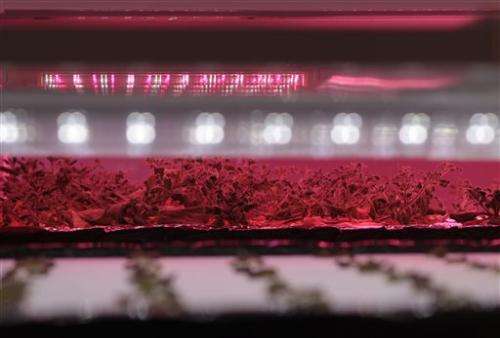
Chang Chen-kai is part of Taiwan's new generation of high-tech farmers that is harnessing the island's technological edge in light-emitting diodes to grow vegetables indoors under bright LED lights.
Chang works in an air-conditioned "grow-room" at a plant factory operated by ARWIN, a biotechnology company, where plants grow in nutrient-filled water instead of soil and the temperature and humidity are controlled. LED lights imitate the cycle of night and day.
These high-tech indoor farms yield more crops per area than soil, and don't need traditional toxic pesticides. Plants grown under LED lights grow twice as fast because the intensity of lights and nutrients provided in the water, growers say.
"To grow vegetables in the water (under lights), you need less land," Chang said, and "you don't need pesticides."
Such plant factories are gaining popularity for raising everything from common lettuce to the exotic ice plant, a thick leafy vegetable from South Africa that looks like it has water bubbles on its leaves and can fetch $400 per kilogram.
In recent years, Taiwanese manufacturers have been able to produce cheaper LED lights that consume less electricity and give off light that mimics the intensity and spectrum of sunlight.
TingMao Agricultural Biotechnology was an early pioneer, starting its plant factory in 2007, and today is the leading producer of LED-grown vegetables in Taiwan. It has also set up its own restaurant using vegetables from its factory to allow consumers to taste the vegetables themselves.
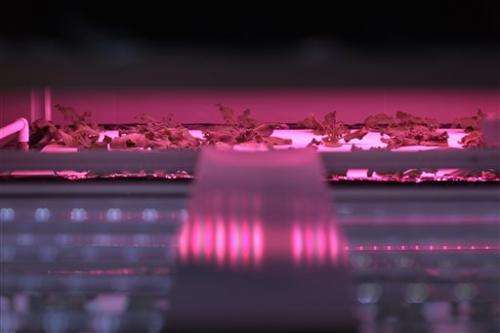
But Lily Chang, a food writer and professor at Innovative Institute of Technology, isn't convinced that LED-grown vegetables are as nutritious as those grown in soil.
"Natural soil-based plants get nutrients from soil," she said, that are "extremely difficult for us humans to manufacture."
Consumers should insist that the government to draw up regulations on the chemicals used in the water of LED-grown plants and hygienic standards, she said.
-
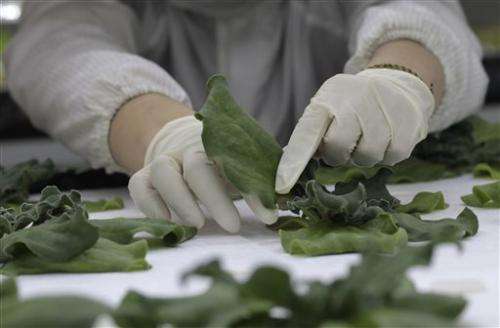
In this photo taken Thursday, March 19, 2015, young South African "Ice Plants", (Mesembryanthemum crystallinum), are trimmed by a technician as they sit under LED light panels in the TingMao Agricultural Biotechnology grow room in Taipei, Taiwan. Entrepreneurs in Taiwan are combining the island's leading edge in light-emitting diodes (LEDs) with its traditional agricultural know-how to create artificial environments to grow vegetables. These indoor grow-rooms have nutrient-filled water instead of soil and variable LED lighting to imitate the cycle of night and day. They are gaining popularity for raising everything from common lettuce to the exotic South African ice plant, which draws US $400 per kilogram. These LED-lit hydroponic environments yield more crops per area than soil but without the need for traditional toxic pesticides. (AP Photo/Wally Santana) -
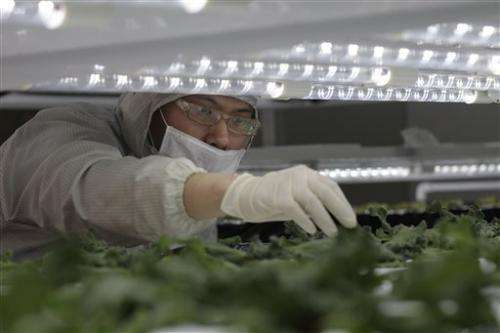
In this photo taken Thursday, March 19, 2015, young South African "Ice Plants", (Mesembryanthemum crystallinum), are trimmed by a technician as they sit under LED light panels in the TingMao Agricultural Biotechnology grow room in Taipei, Taiwan. Entrepreneurs in Taiwan are combining the island's leading edge in light-emitting diodes (LEDs) with its traditional agricultural know-how to create artificial environments to grow vegetables. These indoor grow-rooms have nutrient-filled water instead of soil and variable LED lighting to imitate the cycle of night and day. They are gaining popularity for raising everything from common lettuce to the exotic South African ice plant, which draws US $400 per kilogram. These LED-lit hydroponic environments yield more crops per area than soil but without the need for traditional toxic pesticides. (AP Photo/Wally Santana) -
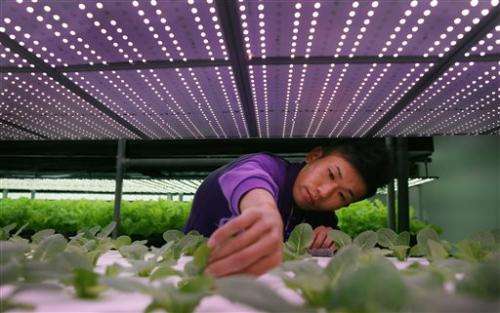
In this photo taken on Wednesday, March 4, 2015, farmer Chang Chen-kai, prunes common salad lettuce growing under banks of LED lights at the ARWIN plant factory in Miaoli, northern Taiwan. Entrepreneurs in Taiwan are combining the island's leading edge in light-emitting diodes (LEDs) with its traditional agricultural know-how to create artificial environments to grow vegetables. These indoor grow-rooms have nutrient-filled water instead of soil and variable LED lighting to imitate the cycle of night and day. They are gaining popularity for raising everything from common lettuce to the exotic South African ice plant, which draws US $400 per kilogram. These LED-lit hydroponic environments yield more crops per area than soil but without the need for traditional toxic pesticides. (AP Photo/Wally Santana) -
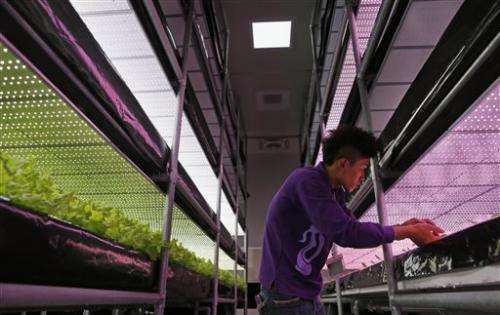
In this photo taken on Wednesday, March 4, 2015, farmer Chang Chen-kai, prunes common salad lettuce growing under banks of LED lights at the ARWIN plant factory in Miaoli, northern Taiwan. Entrepreneurs in Taiwan are combining the island's leading edge in light-emitting diodes (LEDs) with its traditional agricultural know-how to create artificial environments to grow vegetables. These indoor grow-rooms have nutrient-filled water instead of soil and variable LED lighting to imitate the cycle of night and day. They are gaining popularity for raising everything from common lettuce to the exotic South African ice plant, which draws US $400 per kilogram. These LED-lit hydroponic environments yield more crops per area than soil but without the need for traditional toxic pesticides. (AP Photo/Wally Santana) -
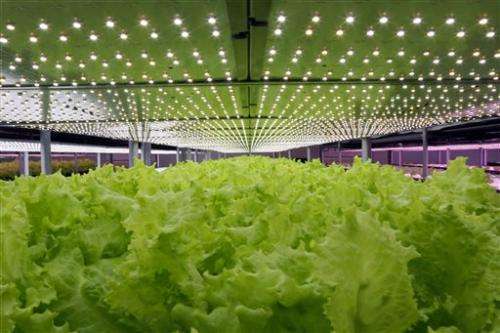
In this photo taken on Wednesday, March 4, 2015, common salad lettuce is seen growing under banks of LED light panels at the ARWIN plant factory in Miaoli, northern Taiwan. Entrepreneurs in Taiwan are combining the island's leading edge in light-emitting diodes (LEDs) with its traditional agricultural know-how to create artificial environments to grow vegetables. These indoor grow-rooms have nutrient-filled water instead of soil and variable LED lighting to imitate the cycle of night and day. They are gaining popularity for raising everything from common lettuce to the exotic South African ice plant, which draws US $400 per kilogram. These LED-lit hydroponic environments yield more crops per area than soil but without the need for traditional toxic pesticides. (AP Photo/Wally Santana) -
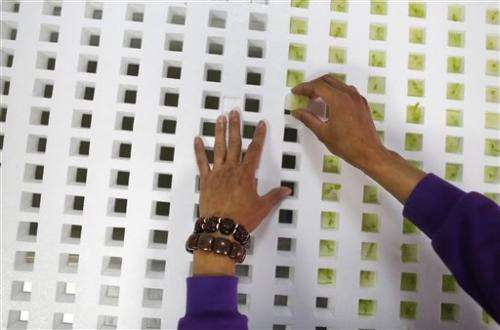
In this photo taken on Wednesday, March 4, 2015, farmer Chang Chen-kai, places seedlings of common salad lettuce into their molds to start growing under banks of LED lights at the ARWIN plant factory in Miaoli, northern Taiwan. Entrepreneurs in Taiwan are combining the island's leading edge in light-emitting diodes (LEDs) with its traditional agricultural know-how to create artificial environments to grow vegetables. These indoor grow-rooms have nutrient-filled water instead of soil and variable LED lighting to imitate the cycle of night and day. They are gaining popularity for raising everything from common lettuce to the exotic South African ice plant, which draws US $400 per kilogram. These LED-lit hydroponic environments yield more crops per area than soil but without the need for traditional toxic pesticides. (AP Photo/Wally Santana) -
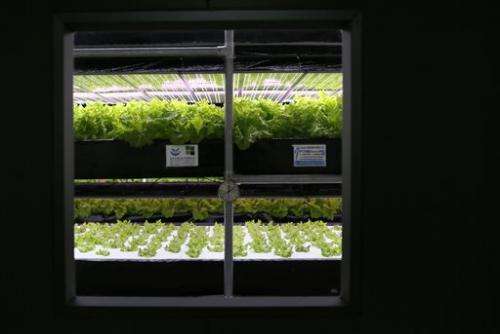
In this photo taken on Wednesday, March 4, 2015, common salad lettuce is seen through a darkened room window, growing under banks of LED lights at the ARWIN plant factory in Miaoli, northern Taiwan. Entrepreneurs in Taiwan are combining the island's leading edge in light-emitting diodes (LEDs) with its traditional agricultural know-how to create artificial environments to grow vegetables. These indoor grow-rooms have nutrient-filled water instead of soil and variable LED lighting to imitate the cycle of night and day. They are gaining popularity for raising everything from common lettuce to the exotic South African ice plant, which draws US $400 per kilogram. These LED-lit hydroponic environments yield more crops per area than soil but without the need for traditional toxic pesticides. (AP Photo/Wally Santana) -
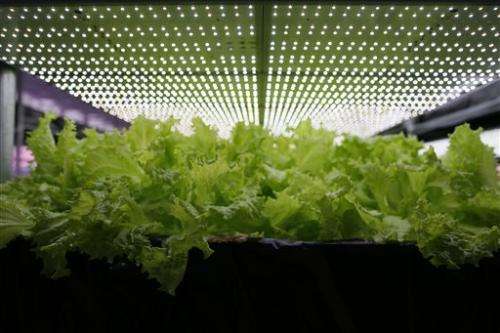
In this photo taken on Wednesday, March 4, 2015, common salad lettuce is seen growing under banks of LED light panels at the ARWIN plant factory in Miaoli, northern Taiwan. Entrepreneurs in Taiwan are combining the island's leading edge in light-emitting diodes (LEDs) with its traditional agricultural know-how to create artificial environments to grow vegetables. These indoor grow-rooms have nutrient-filled water instead of soil and variable LED lighting to imitate the cycle of night and day. They are gaining popularity for raising everything from common lettuce to the exotic South African ice plant, which draws US $400 per kilogram. These LED-lit hydroponic environments yield more crops per area than soil but without the need for traditional toxic pesticides. (AP Photo/Wally Santana) -
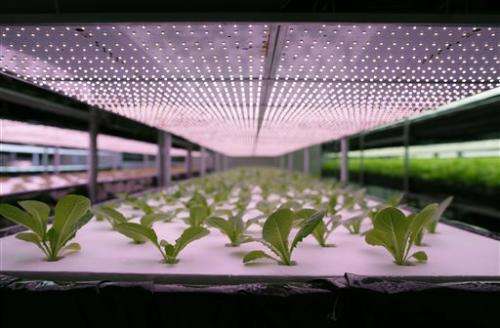
In this photo taken on Wednesday, March 4, 2015, common salad lettuces are seen growing under banks of colored LED light panels at the ARWIN plant factory in Miaoli, northern Taiwan. Entrepreneurs in Taiwan are combining the island's leading edge in light-emitting diodes (LEDs) with its traditional agricultural know-how to create artificial environments to grow vegetables. These indoor grow-rooms have nutrient-filled water instead of soil and variable LED lighting to imitate the cycle of night and day. They are gaining popularity for raising everything from common lettuce to the exotic South African ice plant, which draws US $400 per kilogram. These LED-lit hydroponic environments yield more crops per area than soil but without the need for traditional toxic pesticides. (AP Photo/Wally Santana) -
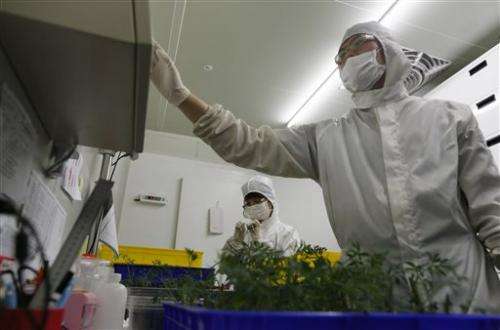
In this photo taken Thursday, March 19, 2015, staff are seen adjusting control panels of the LED light grow-rooms in the TingMao Agricultural Biotechnology grow room in Taipei, Taiwan. Entrepreneurs in Taiwan are combining the island's leading edge in light-emitting diodes (LEDs) with its traditional agricultural know-how to create artificial environments to grow vegetables. These indoor grow-rooms have nutrient-filled water instead of soil and variable LED lighting to imitate the cycle of night and day. They are gaining popularity for raising everything from common lettuce to the exotic South African ice plant, which draws US $400 per kilogram. These LED-lit hydroponic environments yield more crops per area than soil but without the need for traditional toxic pesticides. (AP Photo/Wally Santana) -
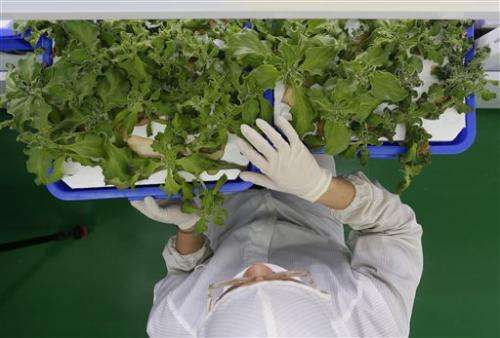
In this photo taken Thursday, March 19, 2015, young South African "Ice Plants", (Mesembryanthemum crystallinum), are trimmed by a staff member as they sit under LED light panels in the TingMao Agricultural Biotechnology grow room in Taipei, Taiwan. Entrepreneurs in Taiwan are combining the island's leading edge in light-emitting diodes (LEDs) with its traditional agricultural know-how to create artificial environments to grow vegetables. These indoor grow-rooms have nutrient-filled water instead of soil and variable LED lighting to imitate the cycle of night and day. They are gaining popularity for raising everything from common lettuce to the exotic South African ice plant, which draws US $400 per kilogram. These LED-lit hydroponic environments yield more crops per area than soil but without the need for traditional toxic pesticides. (AP Photo/Wally Santana) -
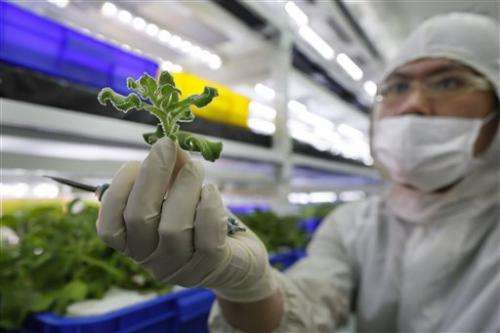
In this photo taken Thursday, March 19, 2015, a technician displays a clipping of a South African "Ice Plant", (Mesembryanthemum crystallinum), from under the LED light panels in the TingMao Agricultural Biotechnology grow room in Taipei, Taiwan. Entrepreneurs in Taiwan are combining the island's leading edge in light-emitting diodes (LEDs) with its traditional agricultural know-how to create artificial environments to grow vegetables. These indoor grow-rooms have nutrient-filled water instead of soil and variable LED lighting to imitate the cycle of night and day. They are gaining popularity for raising everything from common lettuce to the exotic South African ice plant, which draws US $400 per kilogram. These LED-lit hydroponic environments yield more crops per area than soil but without the need for traditional toxic pesticides. (AP Photo/Wally Santana) -
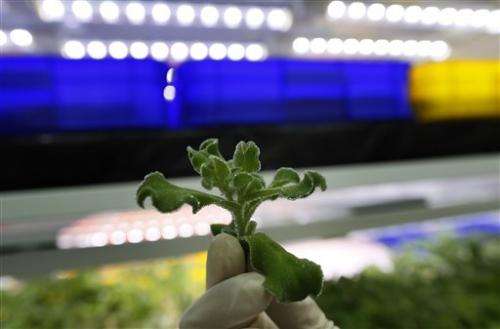
In this photo taken Thursday, March 19, 2015, a technician displays a clipping of a South African "Ice Plant", (Mesembryanthemum crystallinum), from under the LED light panels in the TingMao Agricultural Biotechnology grow room in Taipei, Taiwan. Entrepreneurs in Taiwan are combining the island's leading edge in light-emitting diodes (LEDs) with its traditional agricultural know-how to create artificial environments to grow vegetables. These indoor grow-rooms have nutrient-filled water instead of soil and variable LED lighting to imitate the cycle of night and day. They are gaining popularity for raising everything from common lettuce to the exotic South African ice plant, which draws US $400 per kilogram. These LED-lit hydroponic environments yield more crops per area than soil but without the need for traditional toxic pesticides. (AP Photo/Wally Santana) -
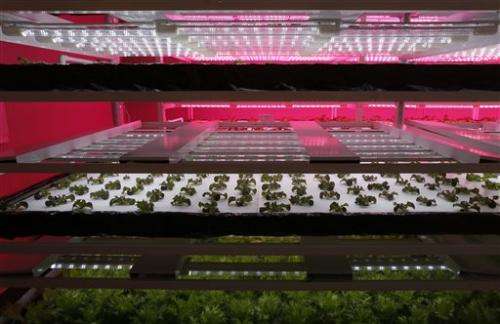
In this photo taken Thursday, March 19, 2015, young South African "Ice Plants", (Mesembryanthemum crystallinum), sit on trays under colored LED light panels in the TingMao Agricultural Biotechnology grow room in Taipei, Taiwan. Entrepreneurs in Taiwan are combining the island's leading edge in light-emitting diodes (LEDs) with its traditional agricultural know-how to create artificial environments to grow vegetables. These indoor grow-rooms have nutrient-filled water instead of soil and variable LED lighting to imitate the cycle of night and day. They are gaining popularity for raising everything from common lettuce to the exotic South African ice plant, which draws US $400 per kilogram. These LED-lit hydroponic environments yield more crops per area than soil but without the need for traditional toxic pesticides. (AP Photo/Wally Santana)
© 2015 The Associated Press. All rights reserved.




















